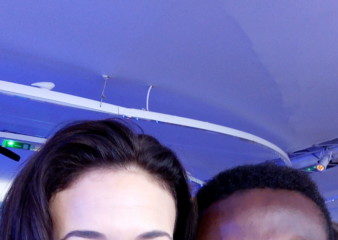Features
Adeleye Sinmi-Adetona: 3 Life Lessons From Learning to Dance Kizomba
 There are several intricate things to learn in the journey of being a deft, smooth and beautiful Kizomba dancer. The Angolan originated dance style has taught me a number of life applicable lessons, and I wonder if the marvelous nature of the dance is because of the evidence of foreign styles mixed with an African original or just because Kizomba is just a marvel.
There are several intricate things to learn in the journey of being a deft, smooth and beautiful Kizomba dancer. The Angolan originated dance style has taught me a number of life applicable lessons, and I wonder if the marvelous nature of the dance is because of the evidence of foreign styles mixed with an African original or just because Kizomba is just a marvel.
Some of the lessons are foundational and basic; patience, consistency and then the art of leading. As basic as these may seem, they are pivotal to the creation of the beautiful and sensual movements that make Kizomba amazing to watch, especially to an audience of non-dancers or early beginners like me.
Here are a few reactions from onlookers of a slow paced Kizomba
- Entranced
- Heart beating fast to slow music
- Imaginary (sometime literal) mouths agape at seemingly sultry nature
- ‘Ok, this is too much. Wow’
You probably get the hint by now that you need to check out a couple of videos. Before you do (show some restraint, come on) I’d like to share with you three interconnected lessons I have discovered while learning to sway and step to the African and Haitian influenced rhythm of Kizomba songs many of which are sung in Portuguese.
These lessons can be developed into habits and skills that are applicable in every sphere or life.
Desire
Everything human action begins with a desire. An action could seemingly be a response to an occurrence; but, always, certain desires, birthed that action.
Taking Kizomba classes for me was birthed from the desire to learn Salsa.
A new acquaintance took me out to my first dance party. To say that I was amazed would be understating how I felt, as the music commanded the atmosphere -giving frequent but very short breaks to allow total strangers enough time to engage in a simple dialogue:
Man: {hand stretched out, small smile on his face and a little tilt of his head} As he asks a mostly non-verbal question: Voulez-vous danser?
Lady: Oui! {or mostly a nod and with a smile she takes his hand and they both move in obedience to the music}
My desire to learn was birthed in those magical moments and I decided to move in the direction of my desire.
The Pivot & Focus
Prior to my first encounter, Salsa was the only non-Nigerian dance I always knew about (asides from Waltz in which I lost interest as I grew out of my Walt Disney inspired fairy tale dreams). I came to recognize the 1-2-3-& 5-6-7 steps of Kizomba, and the 1-2-3-4, 1-2-3-4, foundational steps of Bachata.
My first 2 weeks of classes were exciting, I was catching on fast. My dance partners were impressed whenever I told them that I had only been dancing for 2 weeks. Usually the conversation would go in a manner like this
Me: errr, tu parles anglais? (Do you speak English)
Dance Partner : non, je parle français. {polite smile} Mais Je parle un peu d’anglais (No, I speak French. But I can speak a little English)
Me : uhm err… c’est bon (my intention being to say : that’s ok)
Me : I am not very good dancer (yeah I know, terrible English right?)
Dance partner: {confused look on her face}
Me: Jai apprends danser…errr…..batchata…..err last week (Some poor English… & more terrible French – me saying that I only started learning to dance Batchata last week)
Dance partner: ahh, d’accord (OK) {confused look giving way to an understanding one as she manages to comprehend what I meant and repeats it, in response to which I nod and smile}
Dance partner: {she communicates her understanding and reassures me that she isn’t all that good herself.} Or so I think she says
aaaaand we dance!
However, by the third week, things took a surprisingly different turn. The initial excitement took a nose dive as each new class or dance left me more confused and embarrassed than the previous. My problem was quite simple really, and the solution a lot simpler.
The problem: I was learning three new dances at the same time -Salsa, Bachata and Kizomba. I started to mix up the dances and get the moves all wrong. What more, I had not developed an ear for the music, so when the songs changed and no one was around to tell me, I’d keep trying to dance Bachata to a Salsa song. Of course, it would feel all wrong and look terrible too.
The solution: I needed to choose which dance to learn first, and being that I had seen all three, I knew I wanted to learn Kizomba first. This was my pivot from the original Salsa desire, to something I enjoyed more. I felt like I was going to miss out on learning the popular and well known Salsa; and even the exciting Bachata, but I needed to focus, and focus I did.
Consistency
I am a naturally curious person who likes to try everything. Consequently, I tend to lose interest in the new discovery and move onto to the next best thing. This was the case with my new-found passion for Kizomba and I found myself losing interest. However, being in a new city with an entirely different culture that I was yet to get accustomed to, my evening dance was a precious leisure activity and so I pushed myself to show up and take it seriously. I must confess that I learned a lot more when I was fired up and all giddy, but when I managed to push myself to learn in times when I did not feel like, it reminded me of the original reason for starting the whole journey.
I desired to dance like the pros. I wanted it. I just did. So, I kept at it. Feeling the music vibe or not, I danced. Not feeling like it today or not, I danced. My persistence paid off as I got better in the following weeks. The creeping lack of interest gave way to a new appreciation for the art and a patient approach but dogged attitude.
Lessons in Application
You may choose to apply these lessons in any area you prefer. I have chosen to apply them to my entrepreneurial ventures and build good habits of them so as to transfer them to every area of my life.
First, the ability to identify and move in the direction of my desire is one quality that rewards me with happiness and satisfaction. A prior experience during my NYSC service year gives testament to that (look out for my story “Lessons from the Ceremonial Parade.”)
I believe I have the potential to do – to achieve and to execute; however, the repeated failure to do as desired – giving way to procrastination, excuses, fear of failure and lack of inertia – weakens my resolve and confidence. I have learned that the more I fail to do as greatly desired, the less confident I feel about doing the next important and desired thing. Have you observed this connection in your own personal experiences?
Second: what you focus on expands. – Oprah Winfrey. I find that I need not spend so much energy to get good results on some project, if only I turned off the non-important and non-urgent distractions. A big percentage of focus is in simply saying ‘no’ to the other seemingly important items fighting for your attention. It’s a good habit to learn, saying ‘no’ and focus.
Third: I always had a healthy dislike for anything that required routines and repetitive patterns, but I have come to understand that they were not the end to themselves but the means to build consistency and to eventually achieve the seemingly impossible dream. The sheer power of tiny, supposedly-inconsequential, but repeated actions must not be underestimated.
Thus, I learned the importance and need to create a routine around projects and for things I deem important.
There you have it, my three Kizomba inspired life lessons.
How would you apply them? But first, what do you desire?
Some useful links:
A Kizomba Dance vide
Myths about Kizobma – Busted
Photo Credit: Dreamstime
















